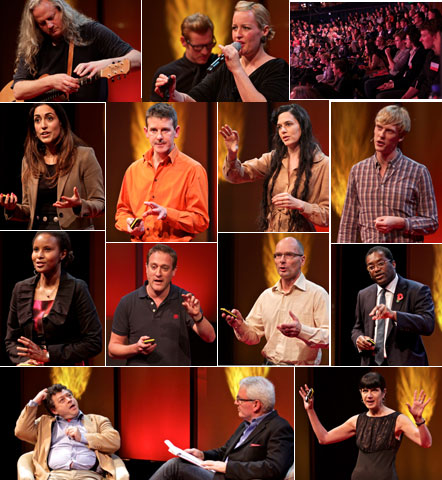“Travels in Space, Time & Imagination” was the theme of the fifth TEDSalon in London, which took place on Thursday 10 November and played to a packed house.
“Journeys can be of many sorts,” TED European director, and the evening’s host, Bruno Giussani said, opening the Salon. And indeed the program was eclectic, featuring nine speakers, two performers, a fireside chat and the unveiling of the new issue of design mind magazine — published by partner frog and fully devoted to TEDGlobal 2011. The audience was also very diverse: 250 attendees gathered at the Unicorn Theatre from all over the UK and from several European countries.
The latest work of the opening speaker, Taryn Simon, is on show (until the end of the year) at the Tate Modern in London and at the Neue Nationalgalerie in Berlin. Titled “A Living Man Declared Dead and Other Chapters,” it is a remarkably insightful investigation into the nature of genealogy and the way our lives are shaped by the interplay of many different forces. Simon spoke at TEDGlobal (see her TEDTalk) three years ago, and has been described by the Observer as “the most important photographer of her generation.” Through powerful and surprising storytelling, she took the audience on a narrated tour of her new work, from India (where we met Chandraban, the man who gives the title to the work, who walked one day into an Indian land registry office to find that he had been declared dead, at the instigation of members of his family who wanted to appropriate his land) to Kenyan healers, modern China, a Ukranian orphanage, occupied Poland, and more.
Mark Rock was next. The founder of Audioboo and creator of a technology that makes it seriously easy to “capture the spoken word,” he believes that the explosion of technology and of online innovation in the last few years has left oral history behind. From the treble of a child’s sadness, to water washing on the shore, an earthquake, or a mother’s voice forever silenced by death, the audience was reminded of the fundamental power of voice, and shown ways to make oral storytelling more permanent.
British soul singer Alice Russell took then the stage, accompanied by guitarist Alex Cowan, for an encore of her TEDGlobal 2011 performance, singing her unique take on “Crazy.”
“There is that other singer, or rather that intriguing pop phenomenon,” said Giussani introducing the next speaker, “a young woman who has gone in four years from absolute anonymity to first-name global recognition.” He was referring to Lady Gaga of course — the topic of Jörg Reckhenrich‘s talk. A German management thinker and artist, Reckhenrich tracked and analized Gaga’s rise and the rules of “Gaganomics.” (Some hints: You gotta have talent, work hard, create a narrative and an emotional impact, and need the ability to orchestrate human relationships.)
Giussani then unveiled the latest issue of design mind magazine, published by frog. The magazine, printed in big format, is rich in articles about TEDGlobal 2011 (of which frog is a partner) and in further explorations of its theme, “The Stuff of Life.” Its cover image is a photo of one of the hundreds of actions around the world prompted by the InsideOut project by JR, the winner of this year’s TED Prize. One of those actions took place in Bastrop, Texas, which was devastated by wildfires — and whose population gathered nonetheless around this artistic project, led by the magazine’s editor Sam Martin, showing strength, resilience and hope. The story is told in this video.
The closing speaker of the first session, Catherine Mayer, Time magazine’s London Bureau Chief, offered in an insightful and witty way her “anatomy of a (new) species” composed of the growing number of people who seem to be living agelessly, as if “the ages of man” had disappeared under the conjunction of higher life expectancy and better socio-economic circumstances. Mayer calls this group — of which she acknowledges she’s part — “amortals.”
The second sessions was opened by neuroscientist Neil Burgess, who tackled the very basic question: “Where did I park my car?” by discussing in details how the brain navigates space and develops virtual “maps” of the locations we have been to. Sensory information from the environment, especially distance and direction to boundaries, captured by place cells and grid cells play a key role in letting us know where we are — or in allowing us to remember where our car is parked, and to find it.
Erik Johansson, a young übertalented Swedish photographer and retoucher, discussed some of his work, which involves the creation of photos that show impossible scenes, but manage to maintain a sense of realism. This “impossible realism” plays on the moment’s hesitation, when seeing his photos, before realizing that while they feel familiar, they have unexpected twists and do not make sense. Photos like this one:
The TEDSalon audience was presented with a copy of The Wiki Man, the just-off-the-presses book by ad guru and TED star Rory Sutherland (see his TEDTalks here and here). Giussani sat down with Sutherland for a conversation about the book — a brilliant pastiche of insight, irreverence and debunking. The often-amusing discussion ranged from behavioral economics (Rory looks forward to the time when Daniel Kahneman’s bus tour will be “overturned by screaming, admiring Japanese school girls”) to the nefarious impact of spreadsheets and from technological innovation to the appropriate age for reading Brave New World.
A glimpse into the future was then provided by Lisa Harouni, the CEO of Digital Forming, which brought along a series of complex 3D-printed objects to make a convincing argument that 3D printing will disrupt the landscape of manufacturing, and will do so soon. As “additive manufacturing” (the technical name) becomes more available and ubiquitous, Harouni said, we will be offered the possibility to download product data from the web, customize it and print locally, instead of shipping the product itself.
Next, Somali archeologist Sada Mire took the audience to the land that she had to flee as a child and where she now heads the Department of Antiquities (when she’s not lecturing in London). Discussing some of her discoveries — cave paintings, ancient writings — she made an impassioned plea for us to start considering cultural heritage as a human right, and culture as an essential building block for reconciliation and healing in countries torn by droughts, wars and ethnic conflicts.
Preston Reed then erupted on stage, and rocked the house with his mindblowing, unique way of playing the acoustic guitar, mixing chord-based grooves and wild polyrhythms with percussive uses of the instrument.
The closing speaker was author and Member of the British Parliament Kwasi Kwarteng, who revisited the hundreds of years and tens of thousands of miles of the British empire, the theme of his recent book Ghosts of Empire. Analyzing how we became the societies that we are today, Kwarteng posited whether the empire was really “nothing more than a series of improvisations conducted by men who had very different ideas about government and administration.”
(Reported by Caitlin Kraft-Buchman. Photos by Robert Leslie. More photos of the event: TED’s Flickr stream. Also, TEDster Nesta Morgan was in the audience and has been drawing the speakers: her sketches are also on Flickr.)


Comments (1)
Pingback: Erik Johansson Photo & Retouch – TED